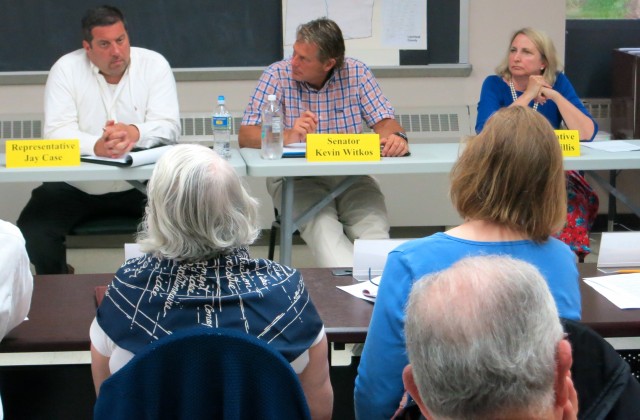Regionalization Committee Meets With State Legislators
Possibility of Legislative Relief Discussed
By Wiley Wood
When it became clear in April that the regionalization plan for Norfolk and Colebrook’s elementary schools faced a legislative roadblock , the study committee invited the state legislators representing the two towns to its May meeting. All three complied.
Roberta Willis (D), state representative for the 64th District including Norfolk, noted that consolidating schools in Connecticut’s smaller towns was an early priority of Governor Dannell Malloy. The governor made incentive money available for regionalization planning. “You’re the only ones,” said Willis, “who have stepped up to the plate.” As the first of Connecticut’s 169 towns to consider regionalizing their elementary schools, Willis added, Norfolk and Colebrook could expect some help.
Jay Case (R), state representative for the 63rd District including Colebrook, and Kevin Witkos (R), state senator for the 8th District, indicated a similar willingness to provide help from the State Capitol. All three legislators stressed that a real consensus in the community would be important to them in steering the issue through legislative shoals or in looking for funds. “I don’t want anyone to feel that we’re going to move forward and push something through that members of the community are very uncomfortable with,” said Willis. “I realize a referendum doesn’t have a hundred percent ‘Yes,’ but we want the sense that a community feels very strongly about something.”
The plan as drafted by the committee includes a clear violation of an existing state statute. Towns in a regional district are meant to calculate their share of the school’s cost on a per-pupil basis. The plan calls for a bend in the cost curve in Colebrook’s favor for an initial period of 10 years.
Any legislative fix, Kevin Witkos pointed out, whether a waiver or a change in the statute, would require a clear signal from the commissioner of education that his department approved the basic concept.
Willis suggested that the state’s legislative attorneys might provide help in drafting the language: “If you’re looking for a legislative fix, you shouldn’t have to pay for that.”
The earliest the question could be resolved by the state legislature would be during next year’s legislative session, which ends July 1, 2015.
With the statutory problems resolved, the plan could go to the State Board of Education for approval in the summer of 2015, then to the two towns for public hearings and referendums that fall. With a ‘Yes’ vote from both towns, the new regional school could be established as early as the 2016-17 school year.
The committee voted to retain the services of Thomas Mooney, an attorney with the law firm of Shipman and Goodwin, for advice on how detailed to make its educational plan. Jonathan Costas, a consultant to the committee, explained that people want a certain degree of detail in order to know what they’re voting for, “but you don’t want to tie the hands of a board more than you have to.”
The plan becomes a blueprint for the future regional board. Incidental changes can be made to it, but any non-incidental changes would need to be added to the plan as amendments, approved by the State Board of Education and voted in by town referendums.
The provisions of the leasing arrangement between the Town of Norfolk and the new regional board also need to be fleshed out, according to Costas. “Basically we have another school year to complete our work.”
The committee disbanded for the summer, having met almost monthly for a year and a half. Its next meeting is scheduled for September 18 at 6:30 p.m. in Room 104 of the Botelle School.

